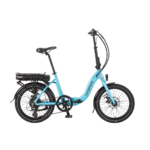Tesla power output
- Thread starter hoppy
- Start date
It's nothing like as extreme a difference as that for our e-bike motors on which power is expressed in watts of course. Typically the net power is at 75% to 80% efficiency, so around that ratio of the gross power (consumption). They are also capable of running continuously at or near to full output without heat damage or other failure, continuous running regarded as the use of the entire battery content.
Most "legal" e-bikes have maximum consumptions between 400 and 600 watts, odd rare ones lower at a little over 300 watts and a few higher with peaks between 700 and 1000 watts. Hub motors appear throughout those powers, but mainstream crank drives are confined to around 400 or 500 watts peak to preserve the bike's transmission.
Most "legal" e-bikes have maximum consumptions between 400 and 600 watts, odd rare ones lower at a little over 300 watts and a few higher with peaks between 700 and 1000 watts. Hub motors appear throughout those powers, but mainstream crank drives are confined to around 400 or 500 watts peak to preserve the bike's transmission.
I have never understood this. That a 250 watt motor can go over that limit. How and when does this happen?
The 250 watt rating is notional, an e-bike that was only capable of 200 or 250 watts continuous would be useless. Originally back around the 1980s they were like that and failed to attract any attention, but by the 1990s manufacturers started to stretch the envelope. My own legal e-bike is capable of continuous net power output onto the road of over 550 watts. Most e-bikes can deliver 400 or more usable watts of power continuously.I have never understood this. That a 250 watt motor can go over that limit. How and when does this happen?
The EN15194 tests show that testing laboratories recognise this and pass much higher than 250 watt power motors as legal. It's all a bit silly really and I hope the European parliament's wish to do away with power limits comes about, since it will do away with the pretext.
See what you mean FleccThe 250 watt rating is notional, an e-bike that was only capable of 200 or 250 watts continuous would be useless. Originally back around the 1980s they were like that and failed to attract any attention, but by the 1990s manufacturers started to stretch the envelope. My own legal e-bike is capable of continuous net power output onto the road of over 550 watts. Most e-bikes can deliver 400 or more usable watts of power continuously.
The EN15194 tests show that testing laboratories recognise this and pass much higher than 250 watt power motors as legal. It's all a bit silly really and I hope the European parliament's wish to do away with power limits comes about, since it will do away with the pretext.

Nikola Tesla sitting in his laboratory in Colorado Springs in December 1899.
Thanks Flecc.
So when a certain manufacturer labels his 'off road' motor as 350 watt, he could just as well label it 250 watt?
So when a certain manufacturer labels his 'off road' motor as 350 watt, he could just as well label it 250 watt?
One scientist member did argue that an e-bikes motor power was whatever the manufacturer labelled it as! There is a degree of support for that, for example Heinzmann make both 200 watt kits for our market (600 watt peak) and also a range of higher powered kits. At one point for the higher powered market they were supplying 400 watt kits which were acknowledged to be exactly the same as those labelled 700 watts! Obviously a matter of markets, some jurisdictions have a 400 watt limit, others like the US federal and China have 700 watt limits, so they just use the appropriate label.Thanks Flecc.
So when a certain manufacturer labels his 'off road' motor as 350 watt, he could just as well label it 250 watt?
However, there seems to be a consensus that around double the legal limit is used by most makers.
Hoppy wished above that manufacturers would supply peak powers, but in fact the information they often give is sufficient for getting the continuous maximum. For example, one very well known and popular manufacturer of higher end bikes has stated he uses 16 Amp controllers now. So 16 times the 37 battery volts is 592 watts, the nominal gross power. At 75 to 80% efficiency the net power into the wheel will be some 440 to 470 watts, close to double the legal limit. When the battery is fully charged and delivering 39 volts under initial load the maximum net power onto the road could be just touching 500 watts.
So you can see that there is more information available than at first might be thought. Electric motors are a well understood technology with no secrets so they are all much the same for a given type. That enables us to draw quite reliable conclusions with little information.
.
Last edited:
Thanks Flecc.
So, my understanding now is as follows:-
It is not the motor, but the controller that determines the actual wattage. Obviously a very small motor, badly overpowered will catch fire, but there is a range of outputs at which a given motor can perform before it overheats.
Is this correct?
Mike
So, my understanding now is as follows:-
It is not the motor, but the controller that determines the actual wattage. Obviously a very small motor, badly overpowered will catch fire, but there is a range of outputs at which a given motor can perform before it overheats.
Is this correct?
Mike
Related Articles
-
 MTF Enterprises announces acquisition of EMU Electric Bikes
MTF Enterprises announces acquisition of EMU Electric Bikes- Started by: Pedelecs
-
 Wisper 806T folding bike wins Which? ‘Best Buy’
Wisper 806T folding bike wins Which? ‘Best Buy’- Started by: Pedelecs
-
 Sustrans calls for protected cycle lanes
Sustrans calls for protected cycle lanes- Started by: Pedelecs
-
 Amazon launch their first UK e-cargo micromobility hub
Amazon launch their first UK e-cargo micromobility hub- Started by: Pedelecs


